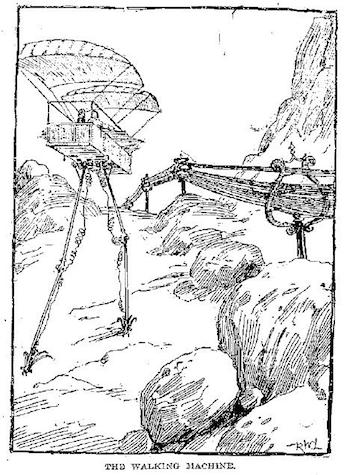Science Fiction
Dictionary
A B C D E F G H I J K L M N O P Q R S T U V W X Y Z
LEONARDO Robot Has Legs And Thrusters, Can Skateboard, Slackline

Caltech's LEONARDO robot (that's LEgs ONboARD drOne, if you're keeping track of complex acronyms) is a multi-modal, bipedal robot using both legs and torso-mounted thrusters.
This allows some very fancy movements.
Creatures that have more than two locomotion modes must learn and master how to properly switch between them. Birds, for instance, undergo a complex yet intriguing behavior at the transitional interface of their two locomotion modes of flying and walking.Similarly, the Leonardo robot uses synchronized control of distributed propeller-based thrusters and leg joints to realize smooth transitions between its flying and walking modes. In particular, the LEO robot follows a smooth flying trajectory up to the landing point prior to landing. The forward landing velocity is then matched to the chosen walking speed, and the walking phase is triggered when one foot touches the ground.
After the touchdown, the robot continues to walk by tracking its walking trajectory. A state machine is run on-board LEO to allow for these smooth transitions, which are detected using contact sensors embedded in the foot.
I'm pretty sure that Thomas Edison had something similar in mind when he worked with George Parsons Lathrop on In the Deep of Time, published in 1897. He describes a "walking balloon":
...they were in Wisconsin, and stepped off into a "walking balloon", which proceeded with long strides of its aluminum legs over a slant of steep upland.
(The Walking Balloon)This vehicle is a shallow car with small hollow sails of silk above it, containing just enough gas to keep it about thirty feet above ground, assisted by a small electric engine in the centre. From the bottom of the car two long rods or mechanical legs, made of aluminum—the lightest metal known— extended down to the ground, where they are reciprocated at regular intervals by an electrometer, which enables them to imitate the motion of walking, and carry the balloon along at the rate of some fifteen miles an hour. They are not meant for high speed, and can travel only, of course, on prepared routes, but are very convenient in certain places.
Via Spectrum.
Scroll down for more stories in the same category. (Story submitted 9/23/2021)
Follow this kind of news @Technovelgy.| Email | RSS | Blog It | Stumble | del.icio.us | Digg | Reddit |
Would
you like to contribute a story tip?
It's easy:
Get the URL of the story, and the related sf author, and add
it here.
Comment/Join discussion ( 0 )
Related News Stories - (" Robotics ")
Golf Ball Test Robot Wears Them Out
"The robot solemnly hit a ball against the wall, picked it up and teed it, hit it again, over and again...' - Frederik Poh, 1954.
PaXini Supersensitive Robot Fingers
'My fingers are not that sensitive...' - Ray Cummings, 1931.
Artificial Skin For Robots Is Coming Right Along
'... an elastic, tinted material that had all the feel and appearance of human flesh and epidermis.' - Harl Vincent (1934)
Robot Guard Dog On Duty
I might also be thinking of K-9 from Doctor Who.
Technovelgy (that's tech-novel-gee!) is devoted to the creative science inventions and ideas of sf authors. Look for the Invention Category that interests you, the Glossary, the Invention Timeline, or see what's New.
Science Fiction
Timeline
1600-1899
1900-1939
1940's 1950's
1960's 1970's
1980's 1990's
2000's 2010's
Current News
Golf Ball Test Robot Wears Them Out
"The robot solemnly hit a ball against the wall, picked it up and teed it, hit it again, over and again...'
Boring Company Vegas Loop Like Asimov Said
'There was a wall ahead... It was riddled with holes that were the mouths of tunnels.'
Rigid Metallic Clothing From Science Fiction To You
'...support the interior human structure against Jupiter’s pull.'
Is The Seattle Ultrasonics C-200 A Heinlein Vibroblade?
'It ain't a vibroblade. It's steel. Messy.'
Roborock Saros Z70 Is A Robot Vacuum With An Arm
'Anything larger than a BB shot it picked up and placed in a tray...'
A Beautiful Visualization Of Compact Food
'The German chemists have discovered how to supply the needed elements in compact, undiluted form...'
Bone-Building Drug Evenity Approved
'Compounds devised by the biochemists for the rapid building of bone...'
Secret Kill Switch Found In Yutong Buses
'The car faltered as the external command came to brake...'
Inmotion Electric Unicycle In Combat
'It is about the size and shape of a kitchen stool, gyro-stabilized...'
Grok Scores Best In Psychological Tests
'Try to find out how he ticks...'
PaXini Supersensitive Robot Fingers
'My fingers are not that sensitive...'
Congress Considers Automatic Emergency Braking, One Hundred Years Too Late
'The greatest problem of all was the elimination of the human element of braking together with its inevitable time lag.'
The Desert Ship Sailed In Imagination
'Across the ancient sea floor a dozen tall, blue-sailed Martian sand ships floated, like blue smoke.'
The Zapata Air Scooter Would Be Great In A Science Fiction Story
'Betty's slapdash style.'
Thermostabilized Wet Meat Product (NASA Prototype)
There are no orbiting Michelin stars. Yet.
Could Crystal Batteries Generate Power For Centuries?
'Power could be compressed thus into an inch-square cube of what looked like blue-white ice'

